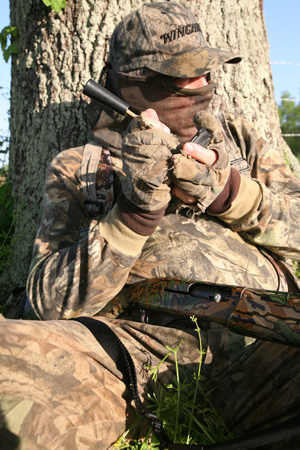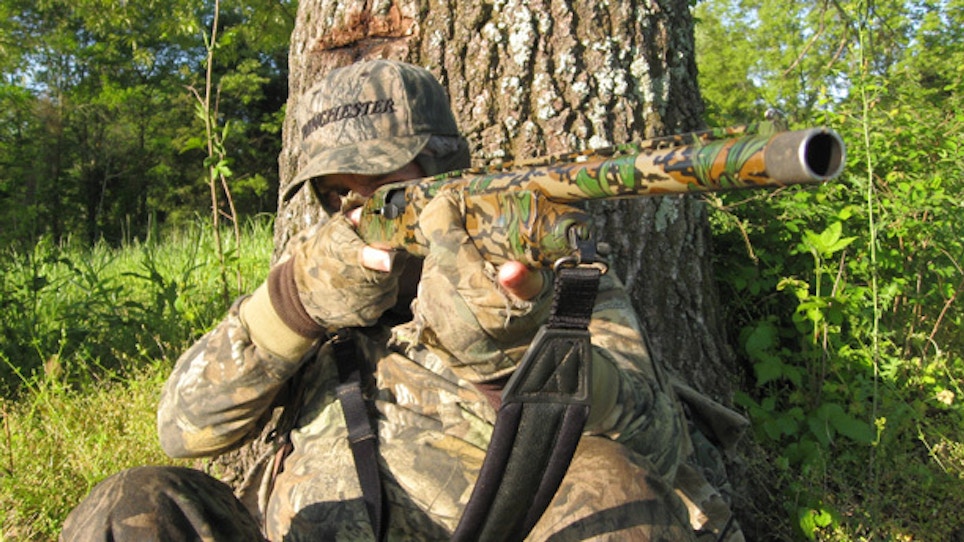Unconventional Tactics to Confuse a Boss Gobbler
I was invited to hunt a smart spring gobbler that had escaped a number of hunters. He had all the other gobblers in a particular river bend shut up. Everyone wanted this bird killed so that the other toms would go back to gobbling.
The first couple of mornings as I tried to set up on the bird, my cover was blown due to my lack of knowledge of the terrain. Both mornings I got the old boss tom to gobble at first light with a crow call, but each time I found that there was a deep creek separating us. That spring the area received an abundance of rain, and the flat bottoms were flooded in many areas.
 On the third morning, I waded through water up to my chest to get on the same side of the slough as him. The gravelly-voiced old boy had about 20 hens roosting in trees near him, and 150 yards was as close as I could safely get.
On the third morning, I waded through water up to my chest to get on the same side of the slough as him. The gravelly-voiced old boy had about 20 hens roosting in trees near him, and 150 yards was as close as I could safely get.
Nothing I did that morning could seal the deal. My best yelps, cackles, and clucks only caused him to double-gobble. When the time came for him to fly down, he headed to the west toward the river with his hens. My attempt to cut him off was foiled by more deep water.
All I could think about was how to outsmart that bird. What now?
My Hunting Plan
As I fretted and fussed, an idea occurred to me – why not try to confuse him? I could approach his roosting area from the river to the west. Then, if he flew down the same direction he had the previous morning, I would be in his line of movement and could call to him. I planned to use a different turkey call that would sound like a different hen.
Then, if I could get another hunter to wade into his roosting area from the east and set up using a gobble box, the gobbler might fly down to fight the intruder. Between an intruding gobbler and a fresh hen, he might make a mistake.
I called a fellow wildlife biologist and told him of my plan. He was game to join the hunt for this well-known gobbler.
Long before dawn the next morning, we waded through chest-high water, working our way into our respective positions. I took advantage of the darkness and moved to within 100 yards of the tall water oaks where the boss gobbler had been roosting. I had a long wait sitting at the base of a large hickory in wet leaves, but I was determined.
As the first red cardinals started calling, I heard soft tree yelps from nearby; the hens were stirring. Then, the object of their affection rocked the woods with a resounding gobble. He was on the same limb as the morning before. It was hard to sit there and not yelp to him, but my co-conspirator and I had agreed not to do anything until the boss was ready to fly down.
A long wait followed. I watched hens nervously moving around on tree limbs almost directly over my head. The old tom gave one of his best performances that morning, breaking the stillness with double-gobble after double-gobble.
As the sun rose in the east, two hens glided down almost at my feet. Then three more sailed over my head, landing behind me and yelping loudly.
Just as the hens passed my head, I heard my friend rattle his gobble box some 200-plus-yards out in front of me. I thought the old boss would burst his voice box as he instantly answered with a loud gobble. My friend came back with a double-gobble. This was too much for the old bird. He flew from his roost and landed somewhere – out of sight – to my right front. When he hit the ground, he gobbled six times.
Then, I got into the act. I gave a loud series of yelps with my mouth call. The bird gobbled back before the last yelp ended.
He was walking quickly 75 yards in front of me. Then my friend gave a double-gobble, and the boss gobbler did an about-face, gobbling continuously as he started back toward him.
For the next five minutes, the boss tom alternated between walking toward my friend, and, when I would yelp back, walking toward me.
All at once, the sound of the phony hen won out, and he started trotting directly to me. The shot was anticlimactic. It was one of the most exciting mornings I had ever enjoyed as a hunter. The boss gobbler weighed only 14 pounds and had few feathers left on his bottom side. He had been a busy gigolo! His spurs were 1-inch-long and he sported an 11-inch beard.
Of course, every hunting scenario is different. What worked today might not succeed tomorrow. The important thing to remember is when you come to a “What now? mornings,” think outside the box and do something the gobbler would never expect.






